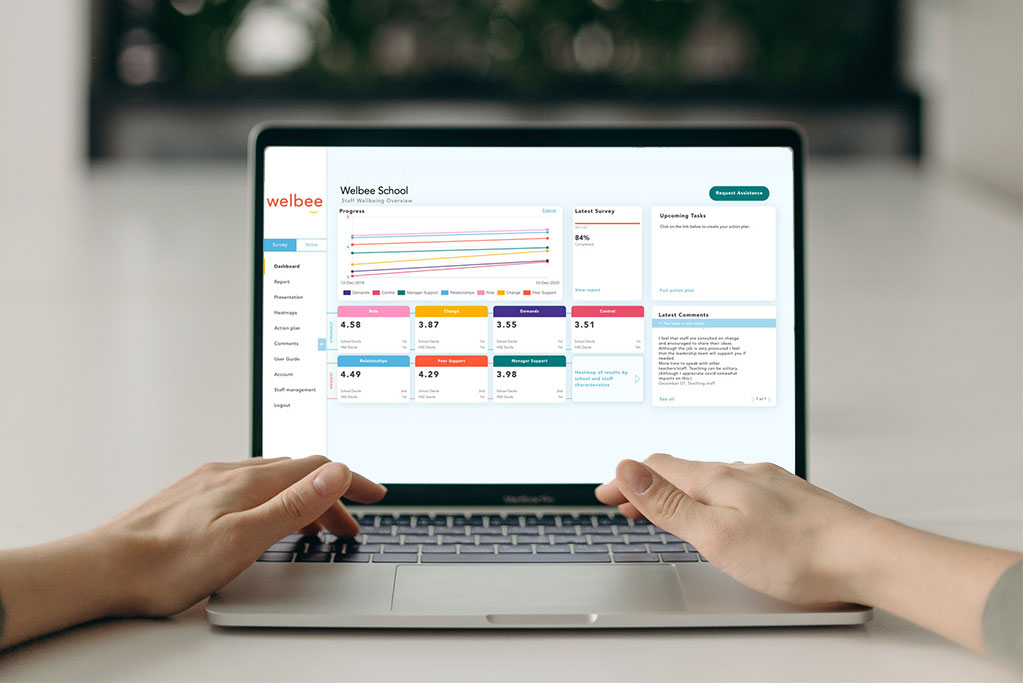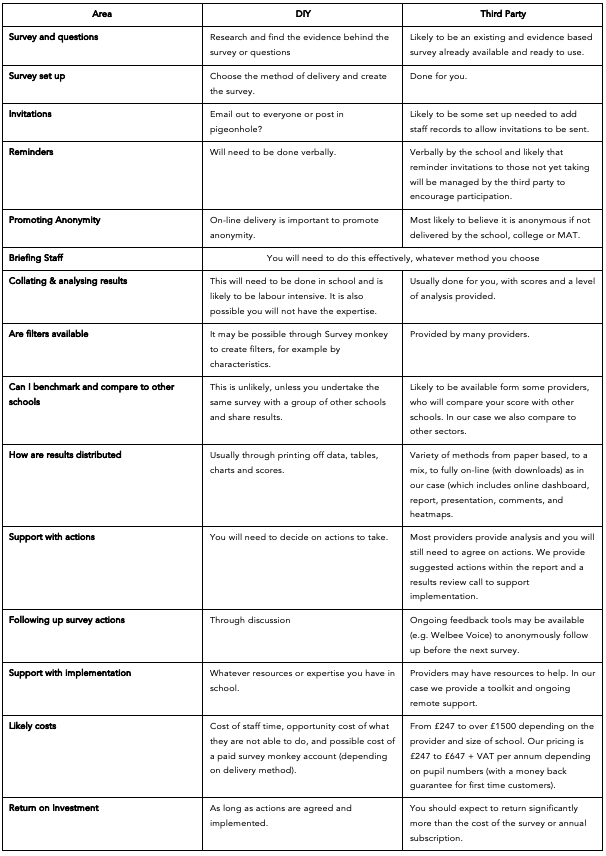
When are you planning to run your next staff wellbeing survey?
The DfE have launched their Education Staff Wellbeing Charter. Commitment 11 says that organisations should “Hold ourselves accountable, including by measuring staff wellbeing.”
It goes on to say, “We will measure the wellbeing of staff using recognised tools and metrics and be transparent about results. We will monitor trends over time, and act in response to changes.”
For English schools and those inspected by Ofsted, it will help you in addressing the new leadership and management judgement – well not so new in terms of its introduction in September 2019, though relatively new in terms of the number of schools inspected. As Ofsted visits return, expect staff and student wellbeing to be a priority. For those under other inspection regimes, I still expect a greater focus on this important area.
Most importantly, after the last 14 months adding to the many problems of teacher retention, absence and mental health, the schools that address this well, are going to have a significant advantage, as are their pupils.
If you want to improve and create an even better climate for your staff, you do need to know where you are now. Like a Sat Nav, it is no use knowing the destination, without understanding where you are starting from.
Whenever you decide to run your next survey, how do you go about running it, to ensure it is as effective as it can be and take appropriate and continuing action?
In the rest of this article I will share the steps needed to run a robust and effective process and one where staff are likely to participate and share their feedback openly. I’ll also share the pros and cons of doing it yourself (DIY) and using a third party.
If you choose DIY, the guidance and suggestions below will help to make sure you do the best job possible and use the findings from your survey to improve your practice for staff (and students).
Staff Wellbeing Survey Checklist
It is all about planning your survey and this goes beyond what questions to ask and when you will run it. You can use the headings below as a checklist. Read all the steps first, as some are interlinked and they are not necessarily in chronological order, as some should be done in parallel.
1. What date will you launch and close your survey?
This step is simply the starting point and many people running surveys do not think about the end to end process that is needed. The most important part is not the survey, but what happens afterwards. So choosing your date for launch allows you to work backwards to your current time and forwards beyond the survey to ensure you have got everything below covered and in place.
One question I am regularly asked is “When is a good time to run the survey?” The problem is that there is not usually a good time, as there is always something else going on. Quiet times simply do not happen in schools and colleges, as you well know.
Instead I ask them to focus on better times and when not to do it. Don’t run your survey in those weeks when there is much more than the simple busy week. Avoid weeks with parent consultations, report writing, or when there are important deadlines.
Beyond this, choose what works best for you. It doesn’t really matter whether you launch in autumn, spring or summer term. Some schools like to fit in with their SDP process for updating plans, others to start the year with it.
If you have not run a survey, or only run one which has not created a school baseline or focussed actions, I would suggest starting as soon as you are able to put your plans together. And in the next best time!
Other things for you to consider are; who will manage the survey, keep on top of participation, ensure it launches and closes on time, and make sure the other elements covered below are delivered.
The CEO, where there is one, Principal, Headteacher and Senior leaders will all need to own the results, (and brief staff) and it will be useful to ensure there is someone appointed to manage the process.
If you have a wellbeing team or committee, you will want their involvement, however this should not remove the need for senior leader support or take away from accountability for managing and delivering the survey.
2. What survey or questions will you use?
Ideally you should use a survey or questions that have an evidence base, are independently evaluated, for example for their psychometric qualities, and look at the key areas for workplace wellbeing. These are the areas you have the greatest impact on and are able to address to create a culture and environment where your staff (and students) want to work and can do their best work.
We recommend the Health and Safety Executive Indicator Tool. It focuses on the six primary stressors identified in the Management Standards approach and the questions are based on the best available evidence linking work design to health outcomes. It was developed to provide a broad indication of how well staff rate performance in managing the risks associated with workplace wellbeing and work related stress.
The other place to look for free survey questions is the What Works Wellbeing Question Bank. Try and find those that have grouped questions and are clear on what they are measuring, and those in the question bank are evidence based and some have benchmarks. Some survey’s simply state they have been developed by psychologists, so look for the evidence behind why questions are asked.
If you decide to create your own questions, be aware of these possible limitations:
- Avoid leading questions that guide people towards a particular answer, by words they use or the way they are asked.
- Accept you may get answers that are difficult to interpret or are unclear in outcomes, as opposed to those developed through an evidence-based approach.
- You are unlikely to be able to benchmark your scores against other schools. When using a Likert scale, often all scores are not equal. Yet we tend to think of 3 as OK, 4 as good, and less than 3 as needing attention. However, it is probable that in some areas a score of 4 will leave you with significant headroom for growth, while a score in the low 3s in another area could be in the top 10% of schools and waste time and effort if you focussed on it.

3. How will you deliver the survey to staff?
You have two main choices.
- Use paper and pen – some schools still do this. It may be easier for those that are less technologically skilled and has one major disadvantage relating to anonymity (see the next section on achieving a high participation rate).
- Deliver it online. The two main tools I see schools using are Survey Monkey and google forms. Both of these can be used for free, though to get a good level of filtering may need a paid account for Survey Monkey.
Whatever method you use, you will need to analyse the results and put them into a useful format to ensure you can use the findings and move to action.
4. What will you do to ensure a high participation rate?
Obtaining a high response rate is important to ensure your results correctly reflect the situation in your school, college or MAT.
As a crude rule of thumb, for a survey of this type, a response rate of over 50% could be considered adequate; over 60% desirable, over 70% good and more than 80% very good. When we work with schools, we always aim to achieve a minimum of 80%, though it is not always possible and particularly in the largest schools.
It is important to get the balance right between encouraging participation and ‘forcing’ people to take part, as the latter will probably mean responses are less likely to be as open as you would want.
With a response rate of less than 50%, the data should be considered as indicative only, and treated with extreme caution.
There are several things you can do to encourage a good response rate before you start your survey. Not least is that staff should feel it is important, that their views matter and that they will be listened to and acted on. Below are some steps you can take.
- Publicise the survey, engage with staff and union representatives and include supportive comments from the CEO, Principal, Headteacher and other senior leaders.
- Ensure that all staff understand:
- The purpose of the survey – why you are doing it?
- Why they should take part – what’s in it for them?
- How and when they will be asked to take the survey.
- How and when they will get feedback on results (at least at a summary level).
- How you intend to address findings.
- Ensure there really is anonymity of responses and staff believe this. Using a paper system is likely to compromise this as staff will correctly think that their responses maybe known or identifiable. While you may intend to maintain anonymity, this will be less obvious to staff. Using on-line methods (or a third party) is likely to re-assure many staff, but not all. The greater their belief that their responses are anonymous and they will not be identified, the greater the likely number of staff who will take part and the greater likelihood that responses will be frank and honest.
You should insert a formal statement of anonymity at the beginning of the survey, as well as communicating this in writing and verbally ahead of the survey. You also need to make sure that the behaviour of all leaders is congruent with this message. It is always possible that a staff member may identify themselves through comments, and if this does take place you must maintain confidentiality and not pursue any individual action. Failure to practise this, as well as demonstrating a lack of integrity, will have repercussions for future survey participation, engagement and the degree to which staff will trust you.
- Give people enough time to complete the survey. This is usually 10 / 15 minutes, though it will depend on the survey and questions chosen, how many there are and whether the survey automatically moves to the next question as the previous one is answered.
- Ensure line managers understand that the process is important and that they encourage their staff to take time to complete the survey.
- Allow staff to complete the survey in work time, where possible, rather than expecting them to complete it in their own time. We know that this provides much better response rates and sends the right message about wellbeing.
- Continue to publicise the survey throughout the process.
- Provide contact for questions or support.

5. How and when will you engage with and brief staff?
Set out ahead of the survey, the information listed above, and makes sure all staff are covered. It is difficult to communicate too much, as long as it is done well, and the right amount needed is usually more often than most school leaders realise.
You might start with a briefing in a staff meeting, follow this up in writing, add it to notice boards and weekly updates and create a countdown. Reiterate anonymity and why it is so important to you. Try and engender a feeling of personal responsibility in taking up the opportunity to provide feedback. Wellbeing is subjective so staff members should not rely on the feedback of others.
Brief all leaders about the key role they have, to encourage the participation of their team members before and during the survey.
6. How will results be collated and analysed?
Running your own survey will mean you need someone or a group to pull together and analyse results. Whether or not you are able to put them into nice tables and charts, you will still need to interpret what these mean.
You may have some staff who are good with data, though you will also need the involvement of those who lead practice across the school. This is likely to be one of the biggest and most time consuming jobs, if you want to use the feedback you have received for action.
Not doing this well, the lack of comparative data with other schools or not understanding what good and less good looks like, are often the reasons why surveys lead to little action, improvement or sustained changes. There was good intent and unactionable results. So plan how you will do this prior to launch.
7. Book time in to review results as a team and as close as possible to closing the survey.
Don’t wait until the survey is closed to book time in or work out how you will do this. To ensure results are shared with staff and action taken, plan this and all steps ahead of launch, at least in outline.
Where it needs people to meet, ensure this is already planned into the diary and stick to the agreed timelines. It demonstrates to staff how important you are taking their feedback and that you listen.
When you get to reviewing results, you will want to identify areas to celebrate, for quick wins, for longer term action and where you might need further discussion or investigation.
It is also where you should look at wider school data and the trends you are seeing, which is something you are probably doing regularly, and will have considered prior to the survey. These are likely to include such things as:
- Absence statistics, the reasons for absence, the impact of cover (on wellbeing and financially) and feedback from return to work and welfare interviews.
- Attrition or Retention statistics (and feedback from effective leaver interviews).
- Use of Employee Assistance Schemes (if you have one) and any other support provided, such as counselling – this will usually be headline and anonymous information.
- Grievances, behaviour issues (students) and relationships.
- Changes in school and student outcomes.
8. Plan to involve your wellbeing team, council or committee (if you have one)
If you have a wellbeing group (whatever you call them), what will their role be? They will be important as supporters, communicators and champions and used well will make a significant difference.
Use them effectively and make sure members are the right ones, and they will support you in providing two way feedback and enabling change. If it is merely a talking (or even moaning) shop then change it.
What a wellbeing group cannot do, is own the response to feedback. This has to come from the senior team.

9. Plan when and how to feedback results to all staff.
You should book in when you will feedback to staff before you launch. If you wait until further down the line, it is more likely to get pushed back, or worse still, missed.
Start with quick or brief feedback first, and as soon after closing as you can. This can be in verbal or in written form and simply needs to thank staff for taking part, remind them of the next part of the process (when they will get fuller feedback) and possibly highlighting one or two headline findings (including celebrations).
Providing fuller feedback is best done face to face, where possible, and in a way that engages staff in action. This should not be about the senior team delivering things for other staff. The senior team are also part of the staff and their wellbeing is also important.
To give focus you may give a summary of results, highlight areas to celebrate and no more than two areas for focus (for now you can say these were the most important findings). You can add more once these have been tackled, if there are any.
Ask what are we going to do to improve this? Whether using a staff meeting or inset day, give some time for staff to share their solutions, so that agreed actions become shared as a school.
Failing to share results, whatever the feedback, means staff are less likely to participate in future surveys or engage with actions. It will also destroy trust.
Failing to ask staff to help create actions and making these shared, means all the workload and accountability falls on senior leaders, reducing their wellbeing and the likelihood of improvements and change.
10. Plan how you will respond to specific staff comments?
Within your survey you should ask a very small number of open comment questions. If you ask too many, you are unlikely to get sufficient responses. Two is a good number, within a larger survey of multiple choice questions.
You might ask a general question about what is going well and what can we do better and then a more specific one.
This will give you some very useful comments to underpin scores and likely actions. You are looking for trends and you can summarise these and share with staff as appropriate. What you can’t do, when doing your own survey, is reply to individual comments.
Finally, remember to not take anything personally. Sometimes difficult, and even in the best schools it is impossible to please everyone and you shouldn’t try! Fair and appropriate action and effective leadership behaviours are the key aim.
11. After feedback and engagement with all staff, finalise goals and actions
Once you have been through the above process you need to set out clear actions.
The step before this is one usually missed by many school leaders – setting goals. As a result of taking action what is it you want to achieve and why. This important for staff buy-in they will want to understand the ‘why’ and be bought in emotionally, as well as practically.
Then be clear on the measurable outcomes and finally what needs to be done to achieve these. It is in implementation where many plans fail! Particularly in not continuing to focus and embed them before moving on to something else.
12. Add actions to the school development plan.
Add actions to the SDP, monitor in the usual way (as long as this is effective) and build what you are doing into business as usual. Staff wellbeing should simply be a part of what happens every day.
Track progress, amend as needed, and use school data, observations, staff discussions and all the items listed in step seven above.
13. Repeat the survey
Ideally use the same evidence backed questions again so you can see exactly what has or hasn’t changed. Scores may go down as well as up, and depending on what may be happening at the school and in the outside education and wider environment, this is both possible and likely.
If you manage this well over time and keep a focus on implementing shared actions as a staff body, your results will improve and deliver the many evidence proven benefits.
Running Your Own Survey
Can you run your own survey? The simple answer is yes and I hope the steps set out above will help you to do this as effectively as you can.
Should you run your own survey? That requires more thought. If it is your only option then go ahead.
If you have an option to consider alternatives, then is it the best approach to use stretched and skilled resource from your own school to undertake something where they are unlikely to have the right knowledge and experience? What are the opportunity costs and what are the costs of staff time in setting up, managing and analysing results.
Below is a table of pros and cons of running your own survey versus letting a third party, like us, take care of it for you.

Thank you for reading and whether you choose to run your survey or allow a third party to support you, please take the time to do it well.
Staff are your most important asset and putting them first has significant benefits for them, your students and the school, both now and for the long-term.
If you have any questions, including those on running your own survey then please let me know. I am keen to help. Our mission is to support all schools to make staff wellbeing simply a part of everyday culture, whether they are a customer or not.
